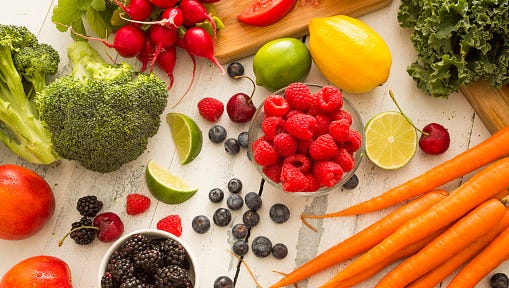Since the Atkins low-carb, high-fat diet exploded onto the American scene, carbs have been labeled bad. Unfortunately, this is only a half-truth and has led to a lot of confusion among the public.
In fact, while some carbohydrates are bad, others are good and should be at the core of a healthy diet. But how can you tell the good carbs from the bad?
Before making that distinction, it’s important to understand that all carbohydrates, good and bad, are made up of various types of sugar, and that can be confusing. The key is how the sugar is packaged and presented to the body.
What is the difference between good carbohydrates and bad carbohydrates?
The first distinction is that good carbs contain natural sugars like those found in fruits, vegetables, and whole grains. Bad carbs, on the other hand, are the “added” sugars in processed foods and sodas, and they get dumped into your coffee or tea.
Smart watches for calorie tracking:Here’s why your smartwatch isn’t good at predicting calories burned during a workout
A second distinction is that good carbohydrates are “complex,” meaning that the sugars are part of a more complex configuration that includes fiber that cannot be broken down in the human digestive system. This slows down the process and that’s a good thing because the sugars in good carbs enter the bloodstream slowly, in a “time release” form. This is important because a slow release of sugar dampens the insulin response. (When blood sugar enters cells and levels in the bloodstream drop, insulin drops as well.)
In contrast, bad carbs are “simple” sugars that enter the bloodstream quickly. When this happens, the body misunderstands what is happening, thinking that a large amount of sugar is coming. In turn, a large insulin response is produced to handle the sugar and escort it into the cells. A high insulin response signals the body to store body fat, especially in the abdominal area as visceral (deep) body fat around the liver and other organs. Excess visceral fat contributes to insulin resistance, prediabetes, and ultimately the onset of type 2 diabetes.
A third distinction is that good carbs provide a host of useful nutrients (vitamins, minerals, and protein), and because they fill you up, you eat less. Bad carbs are sugars that represent “hollow” calories, meaning they provide energy but no nutrients, and excess energy is stored as body fat. Plus, bad carbs don’t satisfy hunger, they inspire you to eat more, consuming more calories and adding even more body fat.
Although excess body fat is a leading cause of health destruction, it’s important to note that sugar itself is a problem. Recent research indicates that people of normal weight who consume too much “added” sugar may double their risk of dying from heart disease.
How can I read food labels to choose good carbohydrates?

Food labels in the past were not always helpful when it came to making good dietary choices. Was it because food producers wanted to keep consumers in the dark, especially those specializing in unhealthy foods that are high in fat and sugar? It sure seems that way.
Consider the fact that in the past, labels didn’t reveal a serving size. So, if the label tells you the product contains 100 calories (kcal) per serving, but doesn’t tell you how many servings are in the package, you may be surprised to learn that there are four servings in the package, for a total than 400 calories This is especially misleading for highly concentrated foods with a high calorie content in a few bites.
Intermittent fasting versus crash diets:What is the best diet to lose weight fast?
Fortunately, after decades of efforts by health advocates seeking to make helpful changes, we now have food labels that make more sense. This has been particularly helpful for carbohydrates on labels. Now, labels tell us how much “added” sugar per serving is in the product. This is important because you can use this valuable information to reduce your bad carb intake.
Keep in mind, however, that “added” sugar is reported in grams and you need to know what this means. Note number four. To interpret and put this into perspective, you should know that there are 4 calories per gram of sugar and 4 grams of sugar in a level teaspoon.
What are the healthy guidelines for added sugar?

For women, the daily maximum should be no more than 6 teaspoons (6 teaspoons x 4 grams of sugar per teaspoon x 4 calories per gram of sugar = 96 calories). For men, the daily maximum should be no more than 9 teaspoons of added sugar (144 calories).
So how are we? The average American consumes a whopping 22 teaspoons of sugar per day (352 calories), with most of it coming from soft drinks. For example, just one 12-ounce can of Coca-Cola contains 9.75 teaspoons of “added” sugar (39 grams). Can you imagine the insanely high sugar intake of people walking around carrying quart-sized sodas and drinking them all day?
Unfortunately, soda isn’t the only culprit. “Added” sugar is everywhere, including candy, cakes, ice cream, fruit juices and canned fruit, fast foods, cereals, and cereal bars. “Added” sugar is also found in many unsuspecting places, including barbecue sauce, ketchup, spaghetti sauce, sports drinks, granola, flavored coffees, high-protein bars, pre-made soups, baked beans canned, pre-made shakes, etc.
Lower back pain:Oh my back! Try these 3 tips to reduce lower back pain and prevent future problems
All carbohydrates do not deserve the bad reputation that has been unfairly foisted on them in recent years. Fruits, vegetables, and whole grains are good complex carbohydrates, loaded with fiber and healthy nutrients. By contrast, some carbs certainly deserve a bad rap, and topping the list are simple carbs, foods high in “added” sugar that only provide calories.
Contact Bryant Stamford, professor of kinesiology and integrative physiology at Hanover College, at [email protected].
